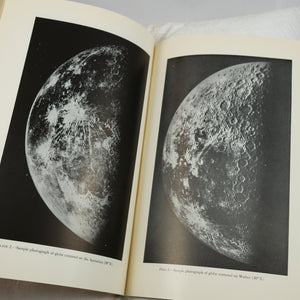Wright, F. E, F. H., and Helen | The Lunar Surface: Introduction
£450.00
-
A rare offprint of a book chapter by the geologist and optical scientist who was considered the foremost authority on the Moon. This copy is inscribed for presentation by his daughter and co-author, science historian Helen Wright, and it comes from the library of Allan R. Sandage, the astronomer who determined the first reasonably accurate values for the Hubble Constant and the age of the universe and was considered “the greatest and most influential observational astronomer of the last half-century” (NY Times obituary, November 17, 2010). Worldcat locates only two other copies of this offprint, at the Huntington and the US Naval Observatory.
Frederick Eugene Wright (1877-1953) spent much of his career at the Carnegie Institute, where he led the Moon Project at the Mount Wilson observatory and “specialized in mineralogy, crystallography and petrology. He developed various optical instruments, chiefly for petrology, and also wrote on the manufacture of optical glass... Wright took a special interest in studying the Moon. He charted all aspects of the orb from its chemical and mineralogical content to the characteristics of its craters and seas and its temperatures. So extensive and detailed was his work that the Moon’s Wright Crater is named after him and two other astronomers” (Optical Society of America biography).
Wright’s daughter Helen began her career as an assistant at Mount Wilson, researching the history of telescopes, and she also worked at the Vassar and U. S. Naval Observatories. Among her publications were biographies of astronomers George Ellery Hale and Maria Mitchell. She has inscribed this copy “Speaking of the Moon! All the best, Helen Wright”. We strongly suspect that it was inscribed for Allan Sandage’s wife, the astronomer Mary Connelly, who had studied at Indiana University and Radcliffe, and was teaching at Mount Holyoke when they met and married.
Allan R. Sandage (1926-2010) completed his physics degree at the University of Illinois in 1948, then became a graduate student at Caltech, where he “learned the nuts and bolts of observing with big telescopes [at the Mount Wilson Observatory] from the founders of modern cosmology, Hubble; Walter Baade, who became his thesis adviser, and Milton Humason, a former mule driver who had become Hubble’s right-hand man” (NY Times). “For his doctoral thesis he studied the stars in the globular cluster Messier 3 and the RR Lyrae variable stars it contains. Refinements in the accuracy of the distances to variable stars became a recurring theme of his work, as these were the first step in determining the ladder of distances through which the true scale of the universe was measured” (Guardian obituary, December 9, 2010).
Sandage’s first major contribution was the 1961 paper, “The Ability of the 200-inch Telescope to Discriminate Between Selected World Models”, which “may well have been ‘the most influential paper ever written in any field even close to cosmology’... It was to set the direction of observational cosmology for 40 years, ruling out the Steady State and the Big Crunch and culminating in the surprise discovery in 1998 that the expansion is not slowing down at all but speeding up” (NY Times). Next, by investigating the motion of old stars in the Milky Way, he and two co-authors showed in 1962 “that that the Milky Way formed from the collapse of a primordial gas cloud probably some 10 billion years ago. That paper still forms the basis of science’s understanding of where the galaxy came from” (NY Times). He continually revised the estimate of Hubble’s constant, the speed at which the universe is expanding. “By 1975 the value, they said, was all the way down to 50, corresponding to an age of as much as 20 billion years, comfortably larger than the ages of galaxies and globular clusters. This allowed them to conclude that the universe was not slowing down enough for gravity to reverse the expansion into a Big Crunch. That was in happy agreement with astronomers who had found that there was not enough matter in the universe to generate the necessary gravity” (NY Times).
-
...Reprinted from Middlehurst and Kuiper: The Moon, Meteorites, and Comets (The Solar System, Vol. IV). Chicago: The University of Chicago Press, 1963.
56-page pamphlet, wire-stitched. Original buff wrappers printed in black. 3 double-sided plates, illustrations and charts within the text. Wrappers a little creased and toned, with some small marks and scratches, minor crease affecting the lower corner of the contents. Very good condition




